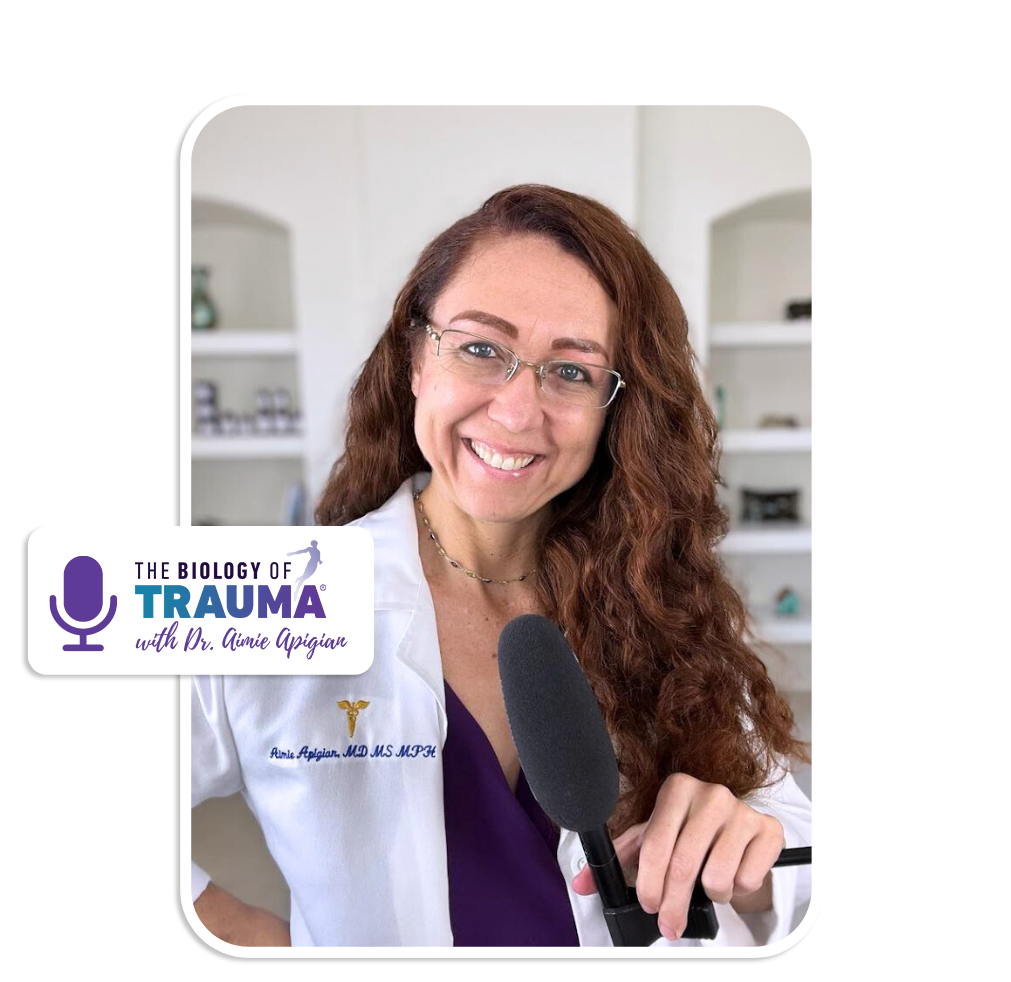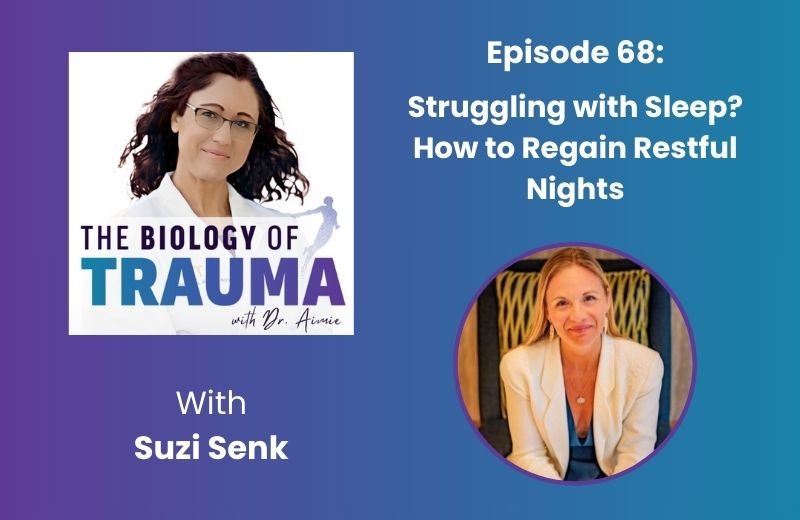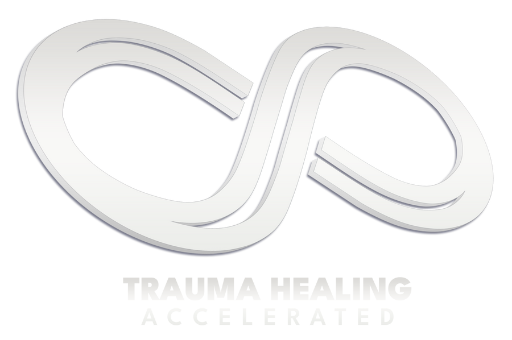


No matter who we are or what we’ve been through, getting good quality sleep can be an immense challenge. Worse yet, is having stored trauma that disrupts our body’s natural ability to relax and feel safe.
Feeling safe enough to relax is a prerequisite for falling and staying in a deep, restorative sleep. Sleep is crucial for our healing journey – yet it can be a cyclical problem. We are stuck… we need effective tools that will not just be a pill.
Sleep is a whole mind-emotion-body experience and requires an integrative and holistic approach that addresses each of those components.
Here is what we need to know about helping our biology help us get good sleep!
The Importance of Your Biology in Sleep
Sleep happens in the parasympathetic state of our autonomic nervous system. That is the state of rest, relaxation and recovery. When we experience a trauma, our nervous system gets stuck in the sympathetic “fight-or-flight” state or the dorsal vagal “freeze” state.
This hypervigilant physiology makes it extremely difficult to transition into the parasympathetic state needed for quality sleep.
At the same time, sleep deprivation perpetuates the trauma response in the body. Without sufficient sleep, we remain in that revved-up sympathetic or shut-down dorsal vagal state. We then lack the resilience to process and integrate our daily experiences.
So while our biology as it relates to trauma disrupts sleep, lack of sleep also disrupts our ability to heal from stored traumas. It’s a vicious cycle that must be broken.
The good news is that by implementing specific hacks and strategies, we can guide our nervous system back into the parasympathetic state. This state is more conducive for sleep – and consequently, will boost our resilience for deeper trauma healing work.
Not sure what that means? There is an Essential Sequence to addressing stored trauma in the body. The right steps in the right order can guide our bodies out of the danger state into parasympathetic. Click here to grab my guide to learn more.
Balancing Hormones and Blood Sugar
Stress, trauma and poor sleep habits disrupt the natural rhythms of hormones like cortisol, adrenaline and melatonin. These are the hormones that regulate our sleep-wake cycles.
Cortisol should peak in the morning, helping us wake up. Then it should decline throughout the day as melatonin rises to induce sleepiness at night. With dysregulated hormones, we may experience high adrenaline which means cortisol at night. This makes it difficult to fall asleep and stay asleep because it doesn’t feel safe to relax.
Balanced blood sugar levels are also critical to make sleep like this possible. Blood sugar spikes or drops prompt adrenaline surges. This will raise blood pressure, which can jolt you awake in the middle of the night.
Aim for three balanced meals per day containing protein, complex carbs, healthy fats and fiber to avoid these fluctuations.
Many people with stored trauma in the body also turn to alcohol or high sugar foods to relax at night. While a temporary fix to relax or numb emotions, these do sabotage sleep by causing blood sugar disruptions.
Replace them with relaxing rituals like an Epsom salt bath with lavender oil. This will provide the magnesium and cues of safety that help our body downshift for sleep.
Eliminate Sleep Saboteurs
For sensitive individuals, certain elements in the sleep environment can unwittingly signal danger to the body. This will keep it in a state of hypervigilance.
We have to take an inventory of our bedrooms. Is there anything that just seems to bother us when we look at it? Remove anything that doesn’t feel completely safe. Even if it doesn’t seem to make logical sense. This may include photos, artwork, electronics or even certain fabrics that our bodies perceive as a threat.
Light is one of the biggest sleep saboteurs. Even small amounts of light can prevent melatonin release and keep our brains in daytime mode. This includes light from the blue/green spectrum, which would be most electronics, phones and TVs.
Use blackout curtains, red light bulbs and blue light-blocking glasses in the evening. Dim all lights as much as possible a few hours before bedtime. That cell phone or computer we use up until we decide to sleep is confusing our light receptors and sabotaging our sleep.
Speaking of electronics, it’s not just the light our biology responds to. Remove as much tech as possible from the bedroom to minimize EMF exposure. Some of us may be very sensitive to this without knowing it. Charging phones in another room and keeping screens, TVs and devices out of our sleep sanctuaries is important.
Pay attention to temperature as well – our bodies are designed to experience a cool down at night as a cue to sleep. Keeping our bedrooms cooler than the rest of the house. Most science confirms cooler than 70 degrees F, and some say as cool as 65 F.
Create a Sense of Safety
For those of us in this restless state, the hardest part of falling asleep is often feeling safe enough to let our guard down. This prevents us from being able to relax into that vulnerable state.
This only amplifies the importance of creating an environment that allows our bodies to experience a true, felt sense of safety.
How can we do this? Start by walking through the home and making sure it feels grounded and secure. Where is there still felt tension or unsettled energy? Cleanse and rearrange as needed.
Learning somatic exercises is how we can intentionally create the sensation of safety right here right now. I am never surprised that those who take the Foundational Journey report 28% reduction in sleep problems in just the first 21 days of the somatic exercises.
To shift our bodies out of this hypervigilant state, we will need to experiment with an amalgamation of the above. Know that this may take some time and trial and error. The right method will anchor that felt sense of safety in our bodies.
The Role of Routine
It’s time for bed! I’m sure we’ve all once despised hearing that. As an adult, developing a consistent pre-bed routine communicates to our bodies that it’s time for sleep mode.
Sticking to the same schedule and sequence of relaxing activities, provides helpful neurological cues.
Be sure to build in a transition period of at least 30-60 minutes. This will help to disengage from stimulating activities like work, exercise, TV/movies, etc.
It is best to not do any exercise at least 4 hours prior to bedtime. That doesn’t mean don’t move! Lol! That means no to the gym, the run, the work-out.
Walks, gentle yoga and the dishes are all activities that will not sabotage your sleep. The exercise and work-out increases your heart rate. This can cause alertness in your body and release hormones that are intended for earlier in the day.
Experiment With Sleep Aids
Natural sleep supplements like magnesium, GABA and l-theanine are great sleep aids. They can help guide our bodies into a restful restorative sleep. (Click here to see the magnesium I use for sleep and why!)
However, be cautious with sleep medications. Many can essentially just force our brains into an unconscious state without true restorative sleep.
The goal for working to regulate our bodies is to get restorative sleep. Have you ever woken up still tired in the morning? That likely was not restorative sleep.
As always, consult a practitioner knowledgeable about sleep protocols.
Breathing and Body Awareness
If we are waking up during the night feeling anxious or like our system is revved up, resist the urge to turn on lights or screens.
Instead, bring attention inward through breathwork. A simple box breathing pattern can quickly calm our physiology. This allows us to re-enter the parasympathetic state for sleep. Try to inhale 4 counts, hold 4 counts, exhale 4 counts, hold 4 counts and repeat.
Gentle body scans and muscle relaxation exercises are other useful tools. These help us get out of our heads and back into our bodies in a regulated way.
Focus on softening areas of tension and reconnecting with the sensations of safety, heaviness and ease. For added weight and touch points, a weighted blanket or scarf is a great option. My favorite is here.
Be Patient and Persistent
Understand that no one has perfect sleep every single night. For those more sensitive individuals, it will take time and consistency to rebuild healthy sleep patterns. Especially after periods of hypervigilance and insomnia.
Celebrate small improvements and don’t get discouraged on nights of poor sleep.
Even a 2-5% increase in quality sleep boosts our bodies’ resilience to do deeper trauma healing work. If unsure where to start, check out my Foundational Journey here!
Pursue a multi-pronged approach addressing biology, beliefs, environment, routines and embodiment practices.
So we keep tweaking, using resources, and being compassionate with ourselves in the process. Quality sleep is key to creating long-term capacity for living fully in the present.
As always, to your health and healing,
Dr. Aimie
I want to hear from you! I would love to hear your thoughts on this episode and let’s make them constructive! A few requests: Please refrain from including URLs and using yours or someone else’s business name to steer clear of spam. Please do use your personal name or initials.
Let’s have a constructive, positive and productive discussion!
You. Calm. Alive.
Be safely guided step-by-step through the essential process for addressing stored trauma in your body.
By listening to this podcast, you agree not to use this podcast as medical advice to treat any medical condition in either yourself or others. Consult your own physician for any medical issues that you may be having. This entire disclaimer also applies to any guests or contributors to the podcast. Under no circumstances shall Trauma Healing Accelerated, any guests or contributors to The Biology of Trauma® podcast, or any employees, associates, or affiliates of Trauma Healing Accelerated be responsible for damages arising from the use of the podcast.
Put your name and email to get my weekly Wednesday newsletter with my Upcoming Events, Masterclasses, Topic Discussions, Free Guides and More.

To safely guide people down their clear path forward to healing. Read More About Us.
© 2023 Trauma Healing Accelerated. All Rights Reserved.